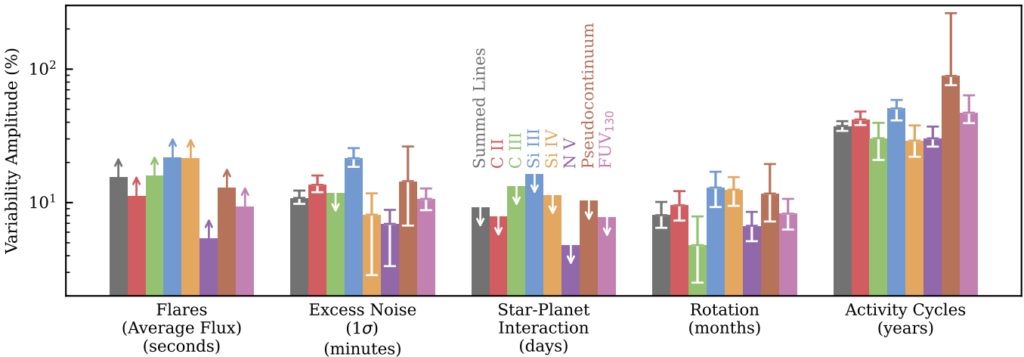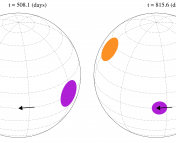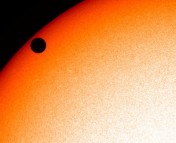Authors: R. O. Parke Loyd, P. C. Schneider, J. A. G. Jackman, K. France, E. L. Shkolnik, N. Arulanantham, P. W. Cauley, J. Llama, and A. C. Schneider
First Author’s Institution: Eureka Scientific, 2452 Delmer Street Suite 100, Oakland, CA, 94602-3017
Status: Published in AAS Journals [open access]
You Go GJ 436
GJ 436 is an old, fairly typical dwarf star orbited by a short-period Neptune-sized planet, GJ 436b. GJ 436b is a pretty famous planet among those who research gas giants with orbits faster than that of Mercury around the Sun. It has become a high-interest target for the James Webb Space Telescope (JWST) with the hopes of characterizing its hot atmosphere. The type, intensity, duration, and frequency of stellar activity all impact the observations and physical evolution of planetary atmospheres. This motivates stellar astronomers, including the authors of today’s paper, to understand what stellar activity looks like for stars like GJ 436.
Activity can take many forms, as listed in the title of today’s paper: flares, stellar rotation, stellar activity cycles, and magnetic star-planet interactions.
- Flares are bursts of activity that typically occur on short-timescales (minutes to hours).
- Stellar rotation refers to the changing view of the surface of a star as it spins, usually over the course of days to weeks.
- A star’s activity cycle is a long-term (several years) shift between low and high amounts of activity.
- And magnetic star-planet interactions (SPI) are a proposed type of activity that can occur when a planet orbits close enough to its host star that its magnetic field interacts with the star’s magnetic field.
All forms of activity lead to changes in a star’s spectrum – the amount and energy of light emitted – which can then lead to changes in an orbiting planet’s atmosphere.
Help Me, Hubble Space Telescope, You’re My Only Hope
Today’s authors focus specifically on the far ultraviolet (FUV) portion of GJ 436’s spectrum. The FUV covers wavelengths between 1150 – 1450 Angstroms – a region of highly energetic light that would give you one heck of a sunburn if Earth’s atmosphere did not protect us. The FUV is important because it drives the creation or destruction of atmospheric molecules like ozone (i.e., atmospheric photochemistry). This means that stellar and planetary astronomers are interested in how the FUV varies with stellar activity. To observe the FUV, one needs the Hubble Space Telescope (HST) as it is currently the only observatory with the ability to observe ultraviolet light at high resolution.
The authors compiled all FUV observations of GJ 436 taken with Hubble’s Cosmic Origins Spectrograph (COS). This data includes three separate groups of observations that span a total of 5 and a half years, which allows the authors to look for stellar activity on short and long timescales. Figure 1 is an average COS spectrum of GJ 436. The authors added up all the FUV light, excluding the gray regions shown in Figure 1, to see how GJ 436’s FUV output changed over the 5.5 years of observations. The emission line behavior over time was analyzed separately.

A Flare For The Magnetic
Emission lines like those of silicon and nitrogen are sensitive to flaring behavior, so the authors identified all fourteen flares present in the data by looking at the total light in all of the FUV emission lines over time. The authors calculated the durations and energies of each flare, included in Table 1 in today’s paper. The flares were then removed from the data so the authors could look for the other forms of variability.
Visible light observations from Fairborn Observatory’s Automatic Photoelectric Telescope were used to measure the periods of the star’s rotation and the star’s activity cycle. Those periods were fixed when the authors fit sine waves to the FUV light curves for stellar rotation and activity cycle. The authors allowed the amplitudes and phase of those sine waves to vary so they could find the best fit. They also included a potential third sine wave to search for any existing magnetic star-planet interactions, which would correspond to the orbital period of the planet.
Results & The Bigger Picture
Unfortunately, no magnetic SPIs were directly detected in the FUV data presented in this work. The authors were able to place a planetary magnetic field upper limit of 10 Gauss (around 0.5 G for Earth) because of their inability to detect any FUV changes due to the planet. However, there were a bunch of frequent, low energy flares detected. Stars like GJ 436 typically exhibit more energetic flares, so the existence of these lower energy flares may be a hint of magnetic star-planet interaction! More work on SPI signatures and disentangling them from plain ol’ stellar activity is needed to tease out the answer.

The variability from all of the forms of activity explored in today’s paper were compared to each other, as shown in Figure 2. The stellar activity cycle dominates the GJ 436’s FUV variability, followed by flares and noise. This means that the largest changes in GJ 436’s FUV emission come from the star’s activity cycle.
GJ 436 is a typical planet-hosting star – meaning that how it behaves is representative of most planet-hosting stars. The results from today’s paper show that most older planet-hosting stars have ultraviolet emission that is likely dominated by their activity cycles. This means that exoplanet astronomers can interpret current exoplanet observations knowing they likely experienced this history within their stellar environment – contributing to their evolution.
Astrobite edited by Archana Aravindan.
Featured image credit: NASA/ESA/STScI/G. Bacon.




